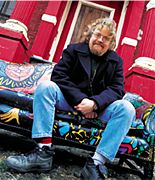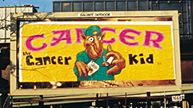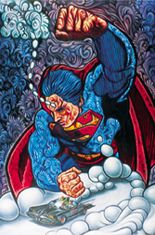 |
 |
||||||
 |
||
|
RON ENGLISH IS AFRAID OF HEIGHTS. Yet, his canvases of choice are billboards, usually suspended hundreds of feet above ground. “It’s a definite downside that most billboards are up high, but the modifications still have to be made,” English says. Yes. Modifications. Billboard modifications. Non- sanctioned billboard modifications. Painter Ron English (’84) is a founding member of the culture-jamming movement, and he is considered a subversive art hero. Commonly known as the “Robin Hood of Madison Avenue,” English first began painting billboards while studying at North Texas. As an art photography student in the early ’80s, he was grappling with how to make his art more visible when he realized billboards would be great canvases. “At first it really wasn’t about the message at all,” English says. “It was just about showing my art. The fact that people wouldn’t know it was mine didn’t matter.” Nearly 20 years and more than a thousand billboards later, it’s not just about visibility. Now, the message matters.
Cowabunga His first subversive billboard depicted Bart Simpson chopping down a rain forest. At the time, Bart was Burger King’s celebrity spokesperson and Burger King reportedly was razing rain forests to make grazing land for its to-be-hamburgers cattle. Since then, no sacred cow has been safe from the images of English. With his own brand of offbeat wit and an amazing technique, English takes on America’s holy trinity: capitalism’s corporate giants, the government and organized religion. But on the billboards, one of his favorite targets is tobacco companies.
“There’s really just nothing good that can be said about tobacco advertisements,” he says. So, in the public’s defense, English created a series of “Cancer Kids” images, which he pasted on Camel billboards. He also created the now famous “Forever KOOL” image — the word “forever” runs vertically along the K in KOOL, and two feet with a toe tag stick out of the O’s. The image was stolen and is used frequently in antismoking campaigns. In a bizarre twist, English was actually hired by Camel a few years ago to create backgrounds for a new ad campaign that was to replace Joe Camel. The new campaign featured art backgrounds that had a “trip-hop” (techno music) feel. “They didn’t know I was among the people attacking cigarette advertising,” English says. “I debated about taking the money but figured it would be wonderfully ironic if they would pay me to do my dirty work.” The partnership lasted about a year — until the executives at Camel realized that when the billboards were viewed from the ground, the background was composed of skulls and crossbones. “They fired me immediately, but it was great while it lasted,” English says.
Painting with a twist Even though English still creates his subvertisements, he also spends a lot of time painting on real canvas — a medium he discovered when he first moved to New York in 1986. “While I was in college, I painted on everything but canvas — my house, my cars, my pet pig and, obviously, billboards,” he says. The canvas paintings, which also are frequently used for commentary, possess an unusually crisp vividness. His images, which look thickly layered, are smooth. And the characters seem real enough to walk out of the picture. Recently he finished a series of “POPaganda” art that featured Disney characters and other popular icons in famous paintings, such as Picasso’s Guernica and da Vinci’s The Last Supper. He also completed a series called “Revisionist Modernism,” in which he altered famous modern paintings. For example, he added Jacqueline Kennedy’s face to Picasso’s Weeping Women. Currently, he is working on a series that merges his childhood with his children’s. In one of these paintings, Bart Simpson sprouts inside Charlie Brown’s head. Another pits Barney against Godzilla. But as is always the case with English’s work, just below the surface there is an energy that says it’s more than a striking picture. So, the next time you look at a billboard, ask yourself if it follows the rules of English. To help you, he has outlined those rules in the painting English 101. In it, he is a teacher in front of a chalkboard on which he has scrawled these and other edicts:
|
||||||||||||||||



